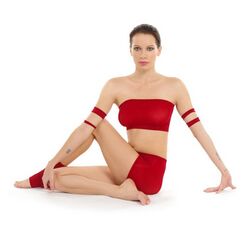Unsolved:Ardha Matsyendrāsana
Ardha Matsyendrasana (Sanskrit: अर्धमत्स्येन्द्रासन; IAST: Ardha Matsyendrāsana), Half Lord of the Fishes Pose,[1] Half Spinal Twist Pose[2] or Vakrasana[3] is an asana. The asana usually appears as a seated spinal twist with many variations, and is one of the twelve basic asanas in many systems of Hatha Yoga.[4]
Etymology
The asana is named after the great yogi Matsyendranath.[5]
The name comes from the Sanskrit words ardha meaning "half", matsya meaning "fish", eendra meaning "king", and asana (आसन ) meaning "posture" or "seat".[6]
The name Vakrasana comes from the Sanskrit word→ "Vakra" ('twisted').[3]
Description
One foot is placed flat on the floor outside the opposite leg and torso twists toward the top leg. The bottom leg may be bent with the foot outside the opposite hip or extended with toes vertically. The arms help leverage the torso into the twist and may be bound (Baddha Ardha Matsyendrasana) in a number of configurations by clutching either feet or opposite hands.
Variations
Ardha Matsyendrasana I
From seated Ardha Padmasana (Half Lotus Pose), the bottom legs extends along the ground, one arm reaches behind the back to grab hold of the foot or shin of the Padmasana leg while the other hand holds the extended leg.[7]
Ardha Matsyendrasana III
From Ardha Matsyendrasana I, the bottom leg moves into Padmasana (Lotus Position) and arms bind by grabbing either foot.[7]
Benefits
Ardha Matsyendrāsana allows the spine to be twisted all the way from the base of the spine to the very top. This asana tones the spinal nerves and ligaments, and improves digestion and also improve liver and pancreas health[8]
See also
- List of asanas
References
- ↑ "Half Lord of the Fishes Pose". Yoga Journal. http://www.yogajournal.com/poses/485. Retrieved 2011-04-09.
- ↑ "Yoga poses, Ardha Matsyendrasana, Half Spinal Twist:". http://www.yogapoint.com/asana/matsyendrasana.html. Retrieved 2011-04-09.
- ↑ 3.0 3.1 "Vakrasana - Twisted Pose". A2Z Yoga. The Yoga Resource Center. http://www.a2zyoga.com/yoga-poses/vakrasana.php. Retrieved 6 May 2013.
- ↑ "The Half Spinal Twist - Ardha-Matsyendrasana". Hatha Yoga. Advaita Yoga Ashrama. http://yoga108.org/pages/show/107-ardha-matsyendrasana-the-half-spinal-twist-yoga-posture. Retrieved 6 May 2013.
- ↑ Maehle, Gregor; Gauci, Monica (November 2009). Ashtanga Yoga - The Intermediate Series: Mythology, Anatomy, and Practice. New World Library. p. 43. ISBN 978-1-57731-669-5. https://books.google.com/books?id=OhYeGdNK0UoC&pg=PA43. Retrieved 9 April 2011.
- ↑ Long, Ray (22 January 2011). Yoga Mat Companion 3: Anatomy for Backbends and Twists. Greenleaf Book (Distributor). p. 162. ISBN 978-1-60743-944-8. https://books.google.com/books?id=iGTIdmn6RgsC&pg=PA162. Retrieved 9 April 2011.
- ↑ 7.0 7.1 Iyengar, B.K.S. (1979). Light on yoga : yoga dipika (Rev. ed.). New York: Schocken Books. ISBN 978-0-8052-0610-4.
- ↑ Yogeswar (1980). Textbook of yoga. Yoga Centre. p. 161. https://books.google.com/books?id=eRUaAAAAMAAJ. Retrieved 9 April 2011.
Further reading
- Iyengar, B. K. S. (1 October 2005). Illustrated Light On Yoga. HarperCollins. ISBN 978-81-7223-606-9. https://books.google.com/books?id=pbx5AAAACAAJ. Retrieved 9 April 2011.
- Saraswati, Swami Satyananda (1 August 2003). Asana Pranayama Mudra Bandha. Nesma Books India. ISBN 978-81-86336-14-4. https://books.google.com/books?id=YpR1QgAACAAJ. Retrieved 9 April 2011.
- Saraswati, Swami Satyananda (January 2004). A Systematic Course in the Ancient Tantric Techniques of Yoga and Kriya. Nesma Books India. ISBN 978-81-85787-08-4. https://books.google.com/books?id=eWOrAAAACAAJ. Retrieved 9 April 2011.
External links



